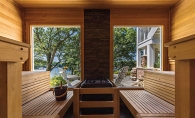How do you transform a house but preserve it at the same time? How do you take an old-fashioned, endlessly subdivided space and turn it into something sweeping, open and modern, all without compromising its essential character? Just ask architecture-slash-design team of Jon and Mary Monson. Their radically redesigned Deephaven lake home looks better than good—it looks like it belongs.
"We wanted to be faithful to what it was, yet at the same time rework it so we could live here the way we wanted to live," Jon Monson says. He stands in his wife's sun-drenched office. The room, with its high ceiling and tall, slender windows, is suffused with a clear, pale light. The family dog, Ivy, a 9-year-old Bichon Frise, is curled up on a cozy-looking armchair, caught by a sunbeam, her white fur aglow.
"This used to be the cook's bedroom," he says, gesturing around him. "All of this was walls. What was most noticeable about this house is that you were at the lake but you didn't even know it."
The house itself dates back to 1892, but was extensively remodeled in 1941. The simple shingle cottage was renovated, winterized and transformed into a Colonial Revival-style home—but it was also highly compartmentalized and closed off from its surroundings.
Monson walks from room to room, pointing out where he and Mary added windows and knocked down walls. The formal dining room and tucked-away kitchen have given way to an open floor plan that subtly separates a large, modern kitchen from a large, open living room, utilizing columns and ceiling treatments to distinguish the spaces.
In the living room, the original windows were saved to showcase the 70-year-old poured glass. "Only two of those windows were on that elevation," he says. Two were moved from around the corner and one was moved in from the den. Even the door that leads out to the lake yard is from 1941. Monson points to the ceiling. "There's a big steel beam up here that holds half the house up so we didn't have to have corners or columns. We made a lot of changes, but hopefully done in a way that you don't realize, that's in keeping with the house's character."
Upstairs, the open floor plan continues. The four small, virtually windowless bedrooms from the 1941 remodel were broken up into a large master bedroom, bathroom, multi-room walk-in closet and laundry room, and a small guest bedroom. The rooms blend together seamlessly but nevertheless feel distinct and separate.
Even the attic has been opened up. Once an unfinished space full of dust and bare rafters (and only accessible by a pull-down ladder), the attic is now a playroom and bedroom for the couple's grandchildren. Here, in perhaps the renovation's cutest touch, four tot-sized beds rest under the attic's tent-like eaves. Designed by Monson and modeled after the barrack bunks at Fort Snelling, they are painted a historically accurate Prussian blue, and the sheets are tucked in with military precision.
History Buff
An architect by trade and the founder of the Landschute Group, a design/build firm based in Excelsior, Monson is also a lifelong history buff. A tattered 44-star American flag from the late nineteenth century—the same era the original house was built—hangs in the stairwell. In places, it's stained a reddish brown. "We don't know if those stains are blood or not," Monson says. "It's possible that this flag saw battle. We don't know, but it's interesting to speculate."
Throughout the house, Monson and Mary utilized original elements of the 1892 cottage, some of them rescued from the effects of the mid-century remodeling. They incorporated old street-side railings into the new balcony, preserved a beadboard soffit, and the floor from the former porch was pulled up and reinstalled in the master bathroom.
"A lot got lost or covered up in the 1941 remodel," Mary says. "Almost all of the beautiful old hardware. Much of the natural wood. In those days, to a lot of people—particularly in the farming community—old was bad, new was good. We took the opposite approach here; we tried to save everything we could."
In the basement, they left the original beams exposed and unfinished, but knocked out a column and replaced it with another steel beam in order to make the space useable. Adjoining the basement is a relic of the atomic age: a bomb shelter, complete with supplies. "It never would have worked," Monson says. "The vents would have sucked the radiation right in. But it's a product of the era, and fortunately no one ever had to use it."
Peeling back the layers was thrilling for the Monsons. "I'm a history nut," Monson says, laughing. "History keeps everything in context. Where we've been and where we are and where we're going is all interrelated." Mary's great-great grandfather settled on Lake Minnetonka in 1853, the same year the lake was officially designated Lake Minnetonka (the Dakota name for it, meaning "Big Water") by Governor Alexander. He was part of the first wave of settlers that fled the sweltering cities of Chicago to live in luxury on the cool shores of the lake.
"There's that thread of continuity and that sense of being working within the historical context of a house that's been here for 118 years; it's very settling. It's what home is all about,” he says.
Mary agrees. "It's very exciting to be a part of this history," she says. "Our family hasn't lived here consistently that whole time, but this kind of brings it full circle. We're back on the lake."

A Preservation-Minded Neighborhood
The Monsons are not the only ones with a passion for preservation. When the Cottagewood General Store, open since 1895, was put up for sale on its 100-year anniversary, the Monsons and 11 other concerned neighbors pitched in to save the store, protecting a piece of neighborhood history. The slender, two-story wood-framed building has become an immensely popular gathering place in the summer, drawing crowds of people every weekend during the summer and even more on special days like the Fourth of July.
"It's the hub of the neighborhood," Monson says. "It brings people together. It's Americana. We could have let it go, but there were enough people who loved that building that we were able to come together as a community as save it. And now if you come out on a Friday night, for grill night, there are a couple hundred people gathered in these woods. It's been just incredible."
When it comes to his own home, Monson says, he feels duty-bound to preserve it. "I feel like we're not just homeowners—we're trustees." Mary agrees. "I just feel so fortunate and privileged to live here,” she says. “To be able to live here in this historic area, in a house like this one, surrounded by such wonderful people—it's just a treat I never could have imagined. As long as we're here, we're going to enjoy every single minute."

A Synergistic Collaboration
The pair approached their own home redesign like any other they build or remodel. "Our primary goal is to make a home beautiful and comfortable," Mary says. "We're small-town folks and we just love to entertain the old fashioned way. We both wanted something that wasn't showy—something simple and truly, naturally beautiful."
They have a lot of experience with simple and beautiful. For almost 40 years, Jon and Mary have followed the "master builder" model: a design process wherein the architect and builder are one and the same.
"In the early days, the architect was the builder," Monson says. "One of the frustrating things for me, as I was growing up and going to school, was that I saw the disconnect between design and construction—how the architect was actually trying to get away from the responsibility and the liability of construction. For years, architects have been giving more and more away, and I think as a result they've had less and less ability to control the outcome of their projects. At Landschute, we are both the architects and the contractors."
The family likes to keep their hands in each aspect of the business; Jon has been a licensed real estate agent since the 1980s, and their son Mike manages real estate and other projects. Mary, though not a licensed architect herself, has a keen eye for design and is an integral part of the process. From the purchase of a property to the completion of the project, the Monsons are there every step of the way.
"We've been together for 40 years," Jon says. "We collaborate. She has her visions and I have mine, but it's a synergistic process. The sum is greater than the parts."









